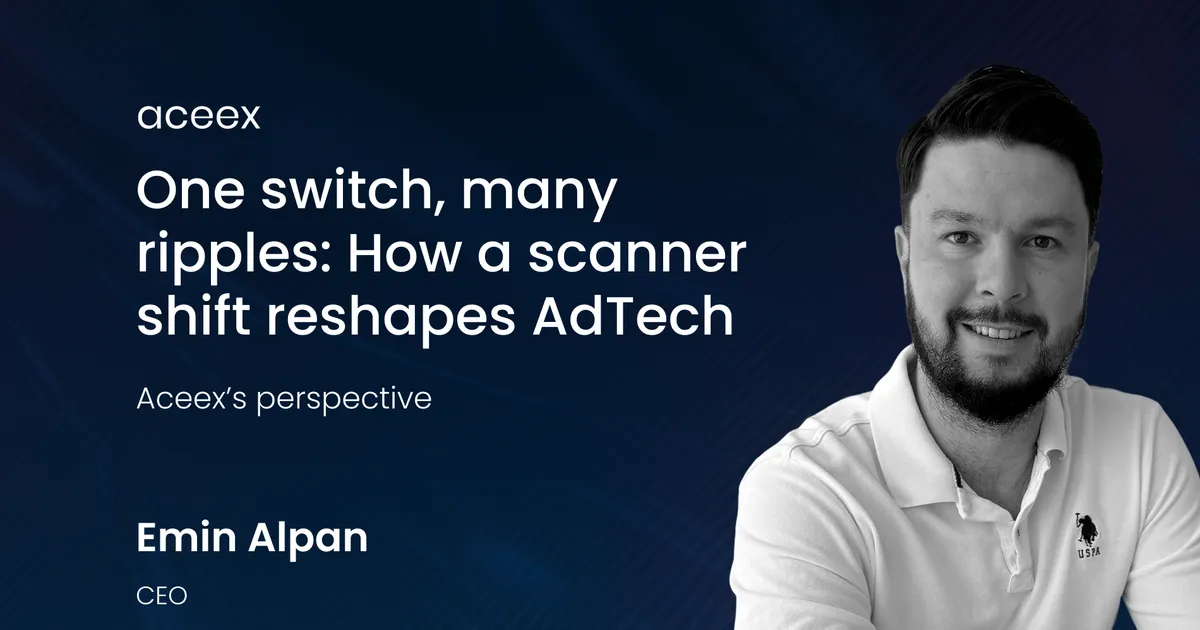Changing traffic validation tools such as switching from one analytics system to another has a significant impact. It’s important to note that this affects not only the technical side of media buying but also the business models of the market participants. It raises critical questions about transparency, adaptation to new standards, and the role of individual players in shaping the rules for the entire AdTech ecosystem.
The industry’s transition from Pixelate to Human security became a symptom of deeper changes in how traffic validation is perceived within the ecosystem. This topic is one of the few loud yet genuinely worthy discussions in today’s AdTech world.
In this conversation, our CEO, Emin Alpan, shared their observations on how a single change triggers a chain reaction across all subsequent layers and what opportunities emerge for publishers and brands.
When did you first hear about the switch to Human security and what surprised you the most?
We’ve been noticing a significant shift since 2022. First of all, more and more industry players have been inquiring about our IVT tool.
The question is what’s driving this trend. There are several technical factors at play, including inconsistencies in determining IVT levels, questions around source legitimacy, and differing methodologies for making deductions. What stood out the most is the realization that, to truly align on IVT levels, we need to be using the same IVT tool.
How has your team’s perception of traffic validity changed since then and what changes are planned moving forward?
At Aceex, we’ve recently implemented several internal changes to strengthen how we assess traffic validity.
As I’ve mentioned before, relying on a single industry-wide solution to detect invalid traffic is not sustainable. When everyone uses the same tool, fraudsters eventually find a workaround. This leaves us blind to evolving threats.
To mitigate this, we always ask both our demand and supply partners which IVT solution they use. We then segment traffic streams accordingly, aligning them with the tools being used to reduce mismatches and ensure accurate detection.
Looking ahead, we’re planning to onboard Human and simultaneously enhance our own internal fraud prevention capabilities. Our goal is to stay proactive in identifying and blocking fraudulent activity before it impacts our partners.
What does this mean for partners working with you? More control or more stress?
No stress at all. We’re actively taking all necessary steps to ensure our partners can feel confident in the traffic they’re buying. With our team we operate with transparency, trust, and a strong drive for growth.
This combination enables us to tailor our approach to each partner’s specific needs, optimizing everything from IVT and CTR to viewability before integration even begins. That level of control translates directly into stronger performance and better outcomes for everyone involved.
Do you expect similar changes in other parts of the stack? Which ones?
When it comes to external technologies and integrations — yes, absolutely. I expect that technologies built for the new era of digital identity will soon begin integrating into the ad tech ecosystem, backed by increasingly sophisticated infrastructure. Over time, this will likely mirror the path we’ve seen with IVT tools, where buyers and sellers need to be part of a specific identity-independent ecosystem in order to transact effectively.
What changes do you foresee in the workflows of publishers and advertisers as a result of this shift?
In my opinion, publishers won’t be as heavily impacted by IVT scrutiny as advertisers will. Genuine sources of organic traffic typically operate independently of which IVT tool is being used. Solutions like Human, DoubleVerify, or Pixalate won’t flag them, simply because there’s nothing to flag.
However, advertisers are a different story. I believe we’ll see more of them asking DSPs pointed questions about which IVT solutions they rely on. It’s a matter of protecting budgets and avoiding waste on fraudulent inventory.
DSPs already offer performance indicators like CTR, viewability, user engagement, and more. I mean metrics that allow advertisers to assess traffic quality.
If an IVT scanner fails to do its job effectively, these metrics will eventually reflect that failure. At that point, advertisers are likely to either switch to another DSP or pressure their current provider to integrate a stronger IVT solution.
The overall sentiment from Emin is clear: the AdTech industry continues to evolve under the pressure of both regulators and market players. The emergence of new standards, even when driven by individual companies, sparks healthy discussion and compels all participants to reconsider their approaches to quality and transparency.
Have your own thoughts on changes in traffic validation? We’re open to continuing this conversation alongside the industry’s leading voices.
